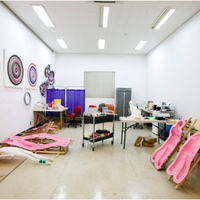The Andrzej Wawrzyniak Asia and Pacific Museum in Warsaw, Poland
 The Asia and Pacific Museum was established in 1973 on the basis of Andrzej Wawrzyniak’s collection donated to the Polish state. At that time, it numbered 4000 pieces of art and ethnographic objects from Indonesia amassed during his 9-year stay in that country as a diplomat. Recognising the fundamental role of its founder, in 2017 the museum changed its name to 'The Andrzej Wawrzyniak Asia and Pacific Museum in Warsaw'.
Beside the initial Indonesian collection – including wonderful side arms, rich textiles, numerous shadow theatre puppets and masks, musical instruments, sculptures and paintings of contemporary artists – Mongolia, India, Nepal, Tibet, Vietnam, Burma, Laos, China, Central Asia (Uzbekistan, Tajikistan, Turkmenistan, Kazakhstan, Kyrgyzstan), Afghanistan, Papua New Guinea and Vanuatu are especially richly represented within the museum’s collection.
Because the museum operated for many years without one permanent exhibition space, the collection was presented at temporary exhibitions, mainly at its two modest galleries: the Asian Gallery and Nusantara, as well as in many places in Poland and abroad. During more than 40 years of activity, the museum has organised nearly 1000 exhibitions, presenting the works of contemporary artists and photographers besides its own collection.
In 2013 the museum moved to a new space where there is also space for future permanent exhibitions alongside new storerooms, a photo studio, conservation workshop, conference hall and educational space.
In 2016 the first part of the permanent exhibition – the “Sound zone” – was opened. The exhibition presents approximately 120 musical instruments originating from various cultural milieux and countries. It includes both simple instruments played by amateurs as well as real masterpieces used by professional musicians at royal courts. The cultural context and functions are illustrated with the help of various multimedia providing the opportunity to learn about the traditional role of an instrument as well as some more contemporary changes in the sphere of music influenced by the intermingling of different cultures.
Collection size: 22,000 inventory numbers
Collection: Ethnology and art of most Asian countries and a part of Pacific area. Most important collections from: Indonesia, India, Nepal, Mongolia, Afghanistan, Central Asia (Turkmenistan, Uzbekistan, Tajikistan etc.), Viet Nam, Burma/Myanmar, Lao PDR, China, Papua New Guinea, Vanuatu etc. The smaller ones from nearly all Asian countries, some Pacific islands and Australia. Also works of Polish artists inspired by Asian cultures and travels.
The Asia and Pacific Museum was established in 1973 on the basis of Andrzej Wawrzyniak’s collection donated to the Polish state. At that time, it numbered 4000 pieces of art and ethnographic objects from Indonesia amassed during his 9-year stay in that country as a diplomat. Recognising the fundamental role of its founder, in 2017 the museum changed its name to 'The Andrzej Wawrzyniak Asia and Pacific Museum in Warsaw'.
Beside the initial Indonesian collection – including wonderful side arms, rich textiles, numerous shadow theatre puppets and masks, musical instruments, sculptures and paintings of contemporary artists – Mongolia, India, Nepal, Tibet, Vietnam, Burma, Laos, China, Central Asia (Uzbekistan, Tajikistan, Turkmenistan, Kazakhstan, Kyrgyzstan), Afghanistan, Papua New Guinea and Vanuatu are especially richly represented within the museum’s collection.
Because the museum operated for many years without one permanent exhibition space, the collection was presented at temporary exhibitions, mainly at its two modest galleries: the Asian Gallery and Nusantara, as well as in many places in Poland and abroad. During more than 40 years of activity, the museum has organised nearly 1000 exhibitions, presenting the works of contemporary artists and photographers besides its own collection.
In 2013 the museum moved to a new space where there is also space for future permanent exhibitions alongside new storerooms, a photo studio, conservation workshop, conference hall and educational space.
In 2016 the first part of the permanent exhibition – the “Sound zone” – was opened. The exhibition presents approximately 120 musical instruments originating from various cultural milieux and countries. It includes both simple instruments played by amateurs as well as real masterpieces used by professional musicians at royal courts. The cultural context and functions are illustrated with the help of various multimedia providing the opportunity to learn about the traditional role of an instrument as well as some more contemporary changes in the sphere of music influenced by the intermingling of different cultures.
Collection size: 22,000 inventory numbers
Collection: Ethnology and art of most Asian countries and a part of Pacific area. Most important collections from: Indonesia, India, Nepal, Mongolia, Afghanistan, Central Asia (Turkmenistan, Uzbekistan, Tajikistan etc.), Viet Nam, Burma/Myanmar, Lao PDR, China, Papua New Guinea, Vanuatu etc. The smaller ones from nearly all Asian countries, some Pacific islands and Australia. Also works of Polish artists inspired by Asian cultures and travels.
Similar content
24 Sep 2016 - 15 Jan 2017
deadline
31 Aug 2011
deadline
05 Sep 2011
deadline
04 Oct 2011
posted on
22 Dec 2022
deadline
22 Oct 2014





